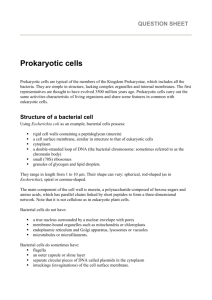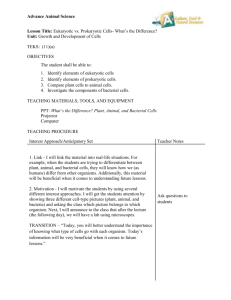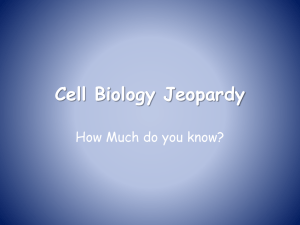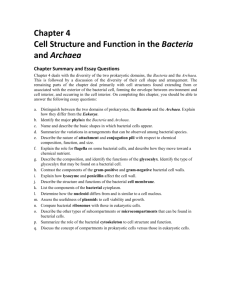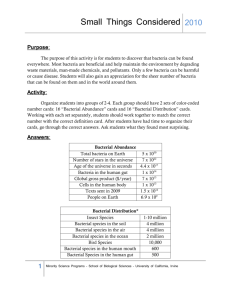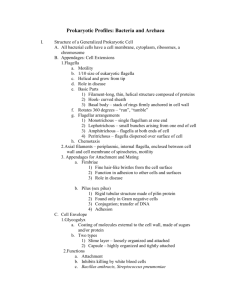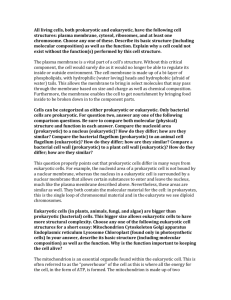What*s the difference? Plant, animal, and bacterial cells
advertisement
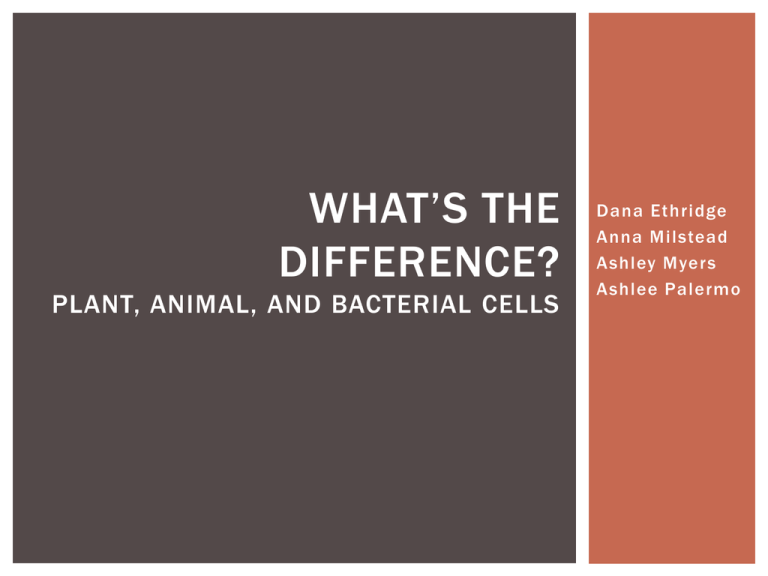
WHAT’S THE DIFFERENCE? PLANT, ANIMAL, AND BACTERIAL CELLS Dana Ethridge Anna Milstead Ashley Myer s Ashlee Palermo OBJECTIVES Identify elements of eukaryotic cells Identify elements of prokaryotic cells. Compare plant cells to animal cells. Investigate the components of bacterial cells. WHAT’S THE DIFFERENCE? Living cells are divided into two types: Eukaryotic (Plant & Animal cells) Prokaryotic (Bacteria) EUKARYOTIC Eukar yotic These cells tend to be larger than the cells of bacteria (prokaryotic) Have a defined nucleus Found in organisms made up of many cells Example: Plant and Animal cells Structure: Cell Membrane Cell Wall (plant cells only) Centrosome Centriole (animal cells only) Chloroplast (plant cells only) Cytoplasm Cytoskeleton Cytosol Golgi Lysosome Mitochondria Nucleus Nucleolus Peroxisome Reticulum Ribosomes Rough Endoplasmic Secretory Vesicle Smooth Endoplasmic Vacuole ANIMAL CELL PLANT CELL ACTUAL PLANT CELLS PLANT CELL ( E UKA RYOTIC ) Unique parts of the plant cell Cell wall – a feature of plants cells that functions like stiff lattice-like wall which helps plant cells maintain their structure and shape Chloroplast – a feature of plant cells that allows plants to do photosynthesis and make their own glucose from sunlight, water and carbon dioxide ACTUAL ANIMAL CELLS ANIMAL CELL ( E UKA RYOTIC ) Unique parts of the animal cell Centriole – a feature of animal cells important for coordinating cell division PROKARYOTIC Prokar yotic These cells are simple in structure No structured nucleus Exist as single-celled organisms Bacteria is both helpful and harmful to us and the environment . Example: Bacterial cells Structure: Capsule (bacterial cells only) Cell wall Chromosomes Cytoplasm Flagellum (bacterial cells only) Inner membrane Outer membrane Pili (bacterial cells only) Ribosomes BACTERIAL CELL ( P ROKA RYOTIC ) Unique parts of the bacterial cell Capsule - Protects the bacterial cell and serves as a barrier against phagocytosis by white blood cells. Flagellum – “Mobility”. Flagella are long appendages which rotate by means of a "motor" located just under the cytoplasmic membrane. Bacteria may have one, a few, or many flagella in different positions on the cell. Pili - These hollow, hair-like structures allow bacteria to attach to other cells. SIMILARITIES Similarities DESCRIPTION 1. DNA/ Chromosomes 2. Cell membrane 3. Structures to produce energy for cell- Cell Respiration 4. Structures that make proteins and enzymes for the cell 5. Cytoplasm Bacterial Cells Yes Yes No-occurs near cell membrane Plant Cells Animal Cells Yes Yes Yes Yes Yes- in organelle Yes- in organelle called called mitochondrion mitochondrion Yes-poly(many) ribosomes Yesendoplasmic reticulum (organelle) Yesendoplasmic reticulum (organelle) Yes Yes Yes DIFFERENCES Differences DESCRIPTION 1. Cell Wall 2. Nucleus-nuclear membrane 3. Fimbria-DNA transfer 4. Vacuoles 5. Chloroplasts (organelles) (for photosynthesis) 6. Flagella-mobility 7. Capsule Bacterial Cells Yes No Some No Yes-blue-green bacteria has a green pigment that makes its own food. Yes Some Plant Cells Animal Cells Yes Yes No Yes No Yes No Yes Yes No No No No No OBJECTIVES Identify elements of eukaryotic cells Identify elements of prokaryotic cells. Compare plant cells to animal cells. Investigate the components of bacterial cells.
